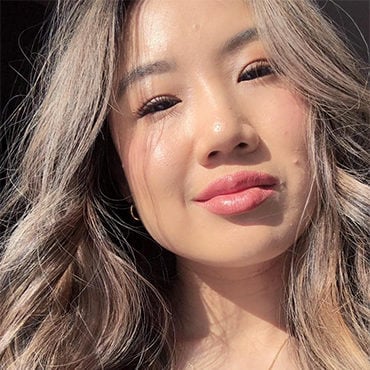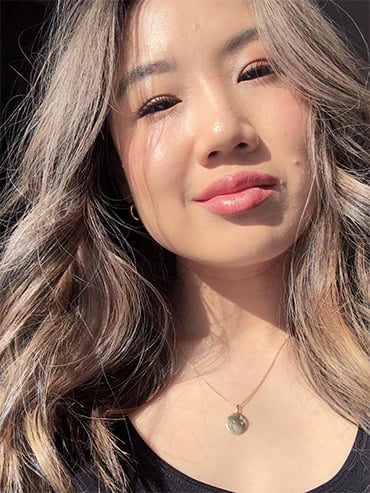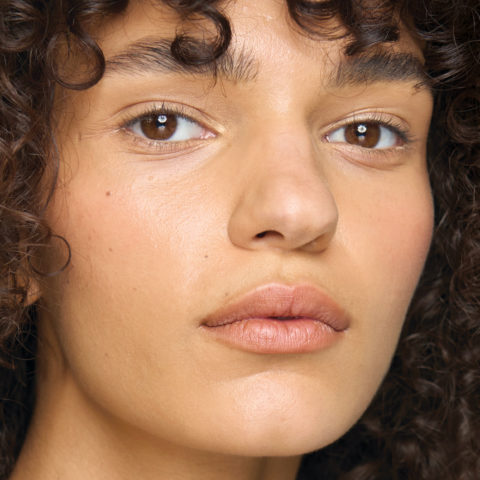I Finally Figured Out How to Get a Brass-Free Blonde for My Asian Hair
Purple shampoo is *not* the answer
I remember the first time I wanted to lighten my hair, my mom gave me a very specific warning: “It’s going to turn orange like those other Asian girls you see with coloured hair.”
I knew very well what she was talking about. I wasn’t surrounded by very many Asian women in my predominantly Caucasian hometown, but any time I went to the nearby Chinese mall or grocery store, I saw girls and women sporting that telltale brassy hue.
Despite the warning signs all around me, I did end up highlighting my hair and, like my mom said, it turned orange. I was mortified. I wanted bleach blonde streaks (ahem… a choice I wouldn’t make now, but at 15 it seemed cool), but instead, I had this copper-y colour that, to me, did not look appealing.
Flash-forward more than a decade and I still get paranoid about my hair turning that dreaded orange. Luckily, I’ve had some really great dye jobs since those first highlights, but I get excessively stressed about maintaining the ashier hues my colourists work so hard to achieve on my dark Asian hair. I’ve invested in countless toning shampoos and am scared to wash my hair with anything else because of one disastrous experience where a supposedly colour-safe shampoo stripped all the toner from my freshly dyed hair and instantly made it—you, guessed—orange.
All of this got me thinking… what is it that makes Asian hair so susceptible to turning orange? And is there any way to avoid it? To find out, I tapped the experts: Jason Lee, Toronto- and New York-based hairstylist and founder of Jason Lee Salon, and Luis Pacheco, Toronto-based hairstylist, founder of Medulla & Co. and creator of TO112. Here’s what I learned:
Brassy hair is not just an Asian problem
It turns out, it’s not just Asians who experience this orange hue when trying to lighten their hair—it’s pretty much anyone with natural dark brown tones. The reason is that dark hair has strong red, orange and yellow pigment undertones. If the hair is not lifted enough during the lightening treatment, the underlying result will be orange. Unfortunately, it takes a lot of work to get to the desired yellow level.
“One of the hardest tones to lift out [on dark hair] are the orange-y ones,” says Lee. “This is often why you will see it in the hair as you go lighter brown to blonde. For people who have lighter hair, they won’t have as many issues because those undertone pigments are not as intense.”
However, he adds that Asian hair has another unique element to it that makes lightening more difficult—an extra cuticle, which makes strands appear healthy and shiny in their natural state, but also makes colour even harder to lift.
“A blonde look isn’t achieved quickly,” Lee says, noting that darker-haired clients should prepare for a full day at the salon if they want to get a cool blonde. Alternatively, the process can be done over two to three appointments, but it’s best to consult with a colourist to determine the right approach, as it can de different for every individual.
Technique is key
This may sound obvious, but here’s the thing: Sometimes it’s hard to tell if your colourist has used a less-than-stellar technique.
According to Pacheco, some stylists may use a product with a high volume of peroxide to lighten dark hair quicker. However, this can damage the hair and make it more porous. When that happens, hair will absorb toner very quickly, but it was also fade just as fast.
Another mistake can be not lifting the hair colour enough. But Pacheco says clients may not be aware of this at first because stylists can easily tone it out to look more ashy. The problem is that toner won’t last.
“I feel like a lot of people formulate to fix a problem and they don’t formulate for the result,” says Pacheco. “[Some stylists may] tone hair out so it looks good when you leave the salon, but then as the artificial pigment starts to fade away, it starts to expose that underlying [orange] pigment again.”
There’s no avoiding the elements
Good dye job or not, your hair will ultimately be affected by sun, pollution and even minerals in your water.
“Water build-up, silicones from products and free radicals can all cause brassiness when they build up on lightened hair,” explains Lee, adding that sometimes the sun can bleach out toner completely and revert the hair back to its orange-y undertones.
Pacheco relates it to blonde swimmers whose hair can go green from repeated chlorine exposure. “The smaller amounts of chlorine in our shower water will also give lightened hair that coppery build-up over time,” he says. To combat this, he uses a treatment rinse at his salon that removes excess minerals like chlorine, calcium and iron from the hair.
Purple shampoo may not be the answer
Just because a purple shampoo says it will combat brass, that doesn’t mean it’ll get rid of orange brass. Remember that colour wheel you were shown in elementary school? If you recall, purple is opposite to yellow, and blue is opposite to orange. Therefore, purple shampoo will not neutralize orange hues… blue shampoo will.
“It’s a mistake a lot of people make,” says Pacheco. “People who have hair that tends to go orange use a purple shampoo but the violet is not strong enough to balance or tone out the orange.” However, he adds that if colour is done right, toning shampoos shouldn’t be needed at all. “You shouldn’t have to rely on a shampoo to fix somebody’s bad formulation,” he says.
Lee does recommend toning shampoos for maintenance between salon appointments, but he warns against overdoing it. “Often, those toning shampoos can eventually start leaving a buildup on the hair and cause a dull appearance and can actually make it harder to lighten afterwards,” he says.
DIY maintainence can extend the life of your look
For days when you don’t use a toning shampoo (or if you choose not to use one at all), Pacheco suggests a shampoo that is colour-safe as well sulphate- and paraben-free. He also advises choosing a shampoo that’s formulated for your scalp condition (is it dry? overly oily?) and to focus on washing the scalp rather than the hair itself. “A lot of people tend to wash their hair, not their scalp. If you focus on cleansing the scalp you’re not washing out the colour as much.”
Pacheco also advises using a conditioner or a mask that is low in pH to help seal the cuticle and lock in that toner. He also recommends products with added protein boosters, like the TO112 Collagen Mask, to make up for the proteins that have been lost in the lightening process.
Lee suggests going back to the salon for toner touch-ups in between lightening appointments. For at-home toning, he recommends Color WOW’s Brass Banned Mousse or Schwarzkopf Professional Igora Expert Mousse, which are super easy to apply.
The colour will eventually fade
As they say, all good things come to an end, including your hair colour. Even the best dye job will fade, but Pacheco says with proper maintenance it should last roughly six to eight weeks. And, again, if the lightening was done correctly it shouldn’t fade to an orange hue, but rather a more neutral colour.
All-in-all, lightening dark Asian is a lot of work, but if you’re willing to spend the time and money on it, you can get the results you’re after.









